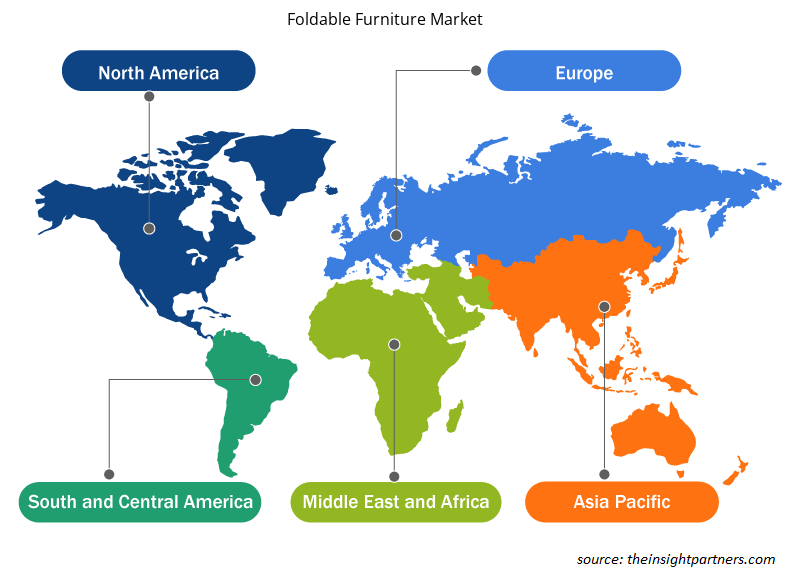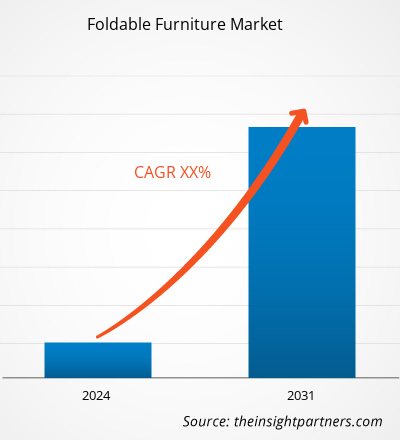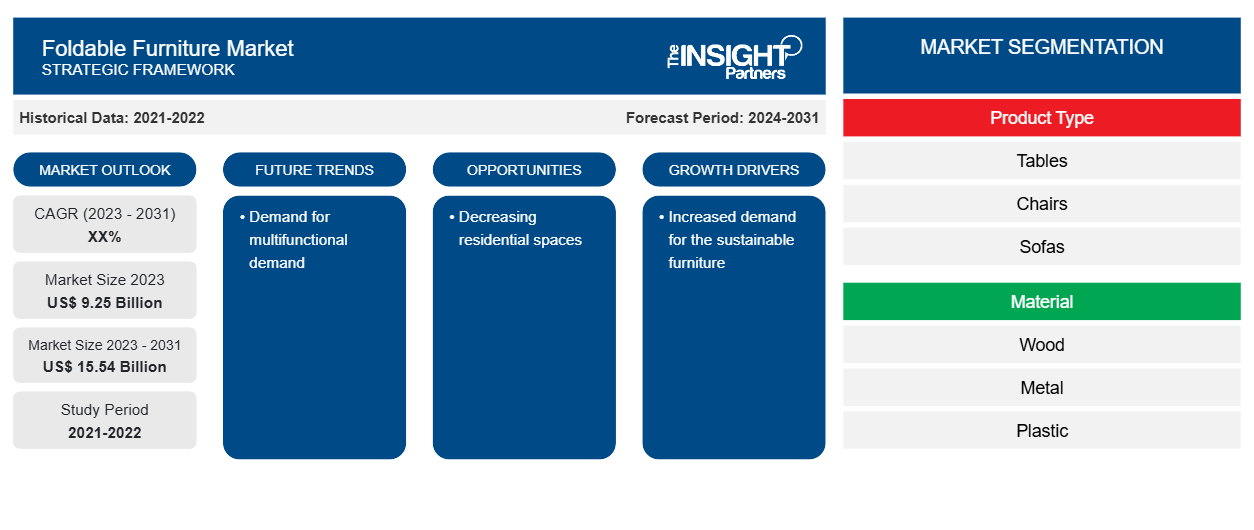Der Markt für faltbare Möbel soll von 9,25 Milliarden US-Dollar im Jahr 2023 auf 15,54 Milliarden US-Dollar im Jahr 2031 anwachsen. Der Markt soll in den Jahren 2023–2031 eine durchschnittliche jährliche Wachstumsrate von XX % verzeichnen. Die Nachfrage nach multifunktionalen Möbeln wächst deutlich. Da die Wohnräume immer kleiner werden, steigt der Bedarf an multifunktionalen Möbeln. Da die Verbraucher zudem umweltbewusster werden, steigt die Nachfrage nach und die Nutzung von faltbaren Möbeln.
Marktanalyse für faltbare Möbel
Die Nachfrage nach Möbeln ist in den letzten Jahren gestiegen. Laut den vom Marketplace veröffentlichten Daten stiegen die Umsätze mit Wohnmöbeln im Januar 2022 im Vergleich zum Dezember 2021 um etwa 7,2 %. Laut den von Forbes im Jahr 2022 veröffentlichten Daten verzeichneten Möbelhändler einen Umsatzanstieg von 64 Milliarden US-Dollar auf 79,9 Milliarden US-Dollar im Jahr 2022, ein Wachstum von 24 %. Dieses Wachstum auf dem Möbelmarkt wirkt sich direkt auf die Nachfrage nach faltbaren Möbeln aus und treibt letztlich den Markt an. Abgesehen von der gestiegenen Nachfrage nach Möbeln treiben die Präsenz von Online-Vertriebskanälen wie Amazon und Alibaba die Verkäufe aufgrund der weltweit gestiegenen Verfügbarkeit weiter an.
Marktübersicht für faltbare Möbel
Die Nachfrage nach dem Produkt wächst in der Region Asien-Pazifik rasant und hält im Prognosezeitraum den höchsten Marktanteil. Einer der Faktoren, die den Marktanteil antreiben, ist die wachsende Bevölkerung in der Region. Laut den vom Bevölkerungsfonds der Vereinten Nationen veröffentlichten Daten leben in der Region Asien-Pazifik etwa 60 % der Weltbevölkerung, also etwa 4,3 Milliarden Menschen. Eine derart wachsende Bevölkerung steigert die Nachfrage nach Möbeln in der Region und treibt letztlich den Markt an. Die Möbelindustrie ist sehr fragmentiert, daher gibt es in der Branche viele Hersteller, die dem Kunden qualitativ hochwertige Dienstleistungen anbieten. Aufgrund der Präsenz der großen Anzahl von Unternehmen in der Branche hat sich der Marktanteil der Branche auf eine große Anzahl von Unternehmen aufgeteilt. Dies erhöht die Verhandlungsmacht des Verbrauchers, da er aus einer großen Auswahl an Optionen wählen kann.
Passen Sie diesen Bericht Ihren Anforderungen an
Sie erhalten kostenlos individuelle Anpassungen an jedem Bericht, einschließlich Teilen dieses Berichts oder einer Analyse auf Länderebene, eines Excel-Datenpakets sowie tolle Angebote und Rabatte für Start-ups und Universitäten.
- Holen Sie sich die wichtigsten Markttrends aus diesem Bericht.Dieses KOSTENLOSE Beispiel umfasst eine Datenanalyse von Markttrends bis hin zu Schätzungen und Prognosen.
Treiber und Chancen auf dem Markt für faltbare Möbel
Erhöhte Nachfrage nach nachhaltigen Möbeln
Da das Bewusstsein für die Dekarbonisierung weltweit zugenommen hat, hat sich auch das Verbraucherverhalten geändert. Verbraucher bevorzugen heute nachhaltige Produkte. Laut öffentlich verfügbaren Daten ist Nachhaltigkeit einer der wichtigsten Faktoren beim Kauf von Produkten, und etwa drei Viertel der Verbraucher weltweit bevorzugen den Kauf nachhaltiger Produkte. Solche Veränderungen im Verbraucherverhalten haben in den letzten Jahren die Nachfrage nach nachhaltigen Möbeln vorangetrieben.
Weniger Wohnraum
Da die Bevölkerung weltweit stark wächst, steigt auch die Nachfrage nach Bauflächen. Allerdings nimmt die Verfügbarkeit geeigneter Grundstücke rapide ab. So ist beispielsweise die Zahl der neu gebauten Häuser insbesondere in Europa und den USA in den letzten Jahren zurückgegangen. Laut den 2023 vom US Census Bureau veröffentlichten Daten lag die durchschnittliche Einwohnerzahl von Einfamilienhäusern im Jahr 2017 bei 2385, im Jahr 2023 lag sie jedoch bei 2179. Dies zeigt die abnehmende Zahl von Wohnflächen im Wohnungsbau. Ein solcher Rückgang der Wohnfläche dürfte in den kommenden Jahren lukrative Möglichkeiten für den Markt für Klappmöbel schaffen.
Marktbericht für faltbare Möbel – Segmentierungsanalyse
Wichtige Segmente, die zur Ableitung der Marktanalyse für faltbare Möbel beigetragen haben, sind Produkttyp, Material, Anwendung und Vertriebskanal.
- Nach Typ ist der Markt für faltbare Möbel in Tische und Stühle, Sofas und Betten sowie Sonstiges unterteilt. Das Segment Tische und Stühle hatte im Jahr 2023 einen größeren Marktanteil.
- Nach Anwendung ist der Markt in Wohn-, Gewerbe- und sonstige Bereiche unterteilt. Das Wohnsegment hatte im Jahr 2023 den größten Marktanteil.
- In Bezug auf die Vertriebskanäle ist der Markt in Online und Offline unterteilt. Der Markt ist je nach Anbietern weiter in Online und Offline unterteilt. Das Online-Segment dominierte den Markt im Jahr 2023.
Marktanteilsanalyse für faltbare Möbel nach Geografie
Der geografische Umfang des Marktberichts für faltbare Möbel ist hauptsächlich in fünf Regionen unterteilt: Nordamerika, Asien-Pazifik, Europa, Naher Osten und Afrika sowie Südamerika/Süd- und Mittelamerika.
Der asiatisch-pazifische Raum dominierte den Markt im Jahr 2023 aufgrund der hohen Nachfrage nach Möbeln. Die Nachfrage nach diesem Markt wird hauptsächlich durch den weltweiten Anstieg des Wohnungsbaus getrieben. In Ländern wie China hat sich die Bautätigkeit in den letzten Jahren vervielfacht. Die gestiegene Nachfrage nach Wohnungsbau hat sich direkt positiv auf die Nachfrage nach faltbaren Möbeln ausgewirkt. Abgesehen vom asiatisch-pazifischen Raum werden Nordamerika und Europa voraussichtlich bedeutende Marktanteile gewinnen.
Regionale Einblicke in den Markt für faltbare Möbel
Die regionalen Trends und Faktoren, die den Markt für faltbare Möbel im Prognosezeitraum beeinflussen, wurden von den Analysten von Insight Partners ausführlich erläutert. In diesem Abschnitt werden auch die Marktsegmente und die Geografie für faltbare Möbel in Nordamerika, Europa, im asiatisch-pazifischen Raum, im Nahen Osten und Afrika sowie in Süd- und Mittelamerika erörtert.Foldable Furniture Market throughout the forecast period have been thoroughly explained by the analysts at Insight Partners. This section also discusses Foldable Furniture Market segments and geography across North America, Europe, Asia Pacific, Middle East and Africa, and South and Central America.

- Holen Sie sich die regionalen Daten für den Markt für faltbare MöbelFoldable Furniture Market
Umfang des Marktberichts über faltbare Möbel Furniture Market Report Scope
| Berichtsattribut | Details |
|---|---|
| Marktgröße im Jahr 2023 | 9,25 Milliarden US-Dollar |
| Marktgröße bis 2031 | 15,54 Milliarden US-Dollar |
| Globale CAGR (2023 - 2031) | XX % |
| Historische Daten | 2021-2022 |
| Prognosezeitraum | 2024–2031 |
| Abgedeckte Segmente | Nach Produkttyp
|
| Abgedeckte Regionen und Länder | Nordamerika
|
| Marktführer und wichtige Unternehmensprofile |
|
Marktteilnehmerdichte: Der Einfluss auf die Geschäftsdynamik
Der Markt für faltbare Möbel wächst rasant, angetrieben durch die steigende Nachfrage der Endverbraucher aufgrund von Faktoren wie sich entwickelnden Verbraucherpräferenzen, technologischen Fortschritten und einem größeren Bewusstsein für die Vorteile des Produkts. Mit steigender Nachfrage erweitern Unternehmen ihr Angebot, entwickeln Innovationen, um die Bedürfnisse der Verbraucher zu erfüllen, und nutzen neue Trends, was das Marktwachstum weiter ankurbelt.
Die Marktteilnehmerdichte bezieht sich auf die Verteilung der Firmen oder Unternehmen, die in einem bestimmten Markt oder einer bestimmten Branche tätig sind. Sie gibt an, wie viele Wettbewerber (Marktteilnehmer) in einem bestimmten Marktraum im Verhältnis zu seiner Größe oder seinem gesamten Marktwert präsent sind.
Die wichtigsten Unternehmen auf dem Markt für faltbare Möbel sind:
- Leggett & Platt Inc.
- Ashley Furniture Industries LLC
- Inter IKEA Holding BV
- Hussey Seating Co
- Sauder Manufacturing Co
- Meco Corp
Haftungsausschluss : Die oben aufgeführten Unternehmen sind nicht in einer bestimmten Reihenfolge aufgeführt.

- Überblick über die wichtigsten Akteure auf dem Markt für faltbare Möbel
Neuigkeiten und aktuelle Entwicklungen zum Markt für faltbare Möbel
Der Markt für faltbare Möbel wird durch die Erhebung qualitativer und quantitativer Daten nach Primär- und Sekundärforschung bewertet, die wichtige Unternehmensveröffentlichungen, Verbandsdaten und Datenbanken umfasst. Im Folgenden finden Sie eine Liste der Entwicklungen auf dem Markt für faltbare Möbel und Strategien:
- Cover Home hat seine innovative faltbare Matratze und Smart-Home- Möbel in Marokko auf den Markt gebracht. Die neue Produktlinie ist speziell auf die sich entwickelnden Anforderungen moderner Haushalte ausgerichtet. (Quelle: Cover Home, Pressemitteilung/Unternehmenswebsite/Newsletter, 2024)
- Livinbox hat seinen neuen Klapphocker CH-40 auf den Markt gebracht. Der Klapphocker von Livinbox ist ein multifunktionales Muss für Erwachsene und Kinder. Er ist leicht, hoch belastbar und platzsparend. Die Tragfähigkeit beträgt bis zu 120 kg für den Schwerlasteinsatz. (Quelle: Name des Unternehmens für faltbare Möbel, Pressemitteilung/Unternehmenswebsite/Newsletter, 2023)
Marktbericht zu faltbaren Möbeln – Umfang und Ergebnisse
Der Bericht „Marktgröße und Prognose für faltbare Möbel (2021–2031)“ bietet eine detaillierte Analyse des Marktes, die die folgenden Bereiche abdeckt:
- Marktgröße und Prognose auf globaler, regionaler und Länderebene für alle wichtigen Marktsegmente, die im Rahmen des Projekts abgedeckt sind
- Marktdynamik wie Treiber, Beschränkungen und wichtige Chancen
- Wichtige Zukunftstrends
- Detaillierte PEST/Porters Five Forces- und SWOT-Analyse
- Globale und regionale Marktanalyse mit wichtigen Markttrends, wichtigen Akteuren, Vorschriften und aktuellen Marktentwicklungen
- Branchenlandschaft und Wettbewerbsanalyse, einschließlich Marktkonzentration, Heatmap-Analyse, prominenten Akteuren und aktuellen Entwicklungen
- Detaillierte Firmenprofile
- Historische Analyse (2 Jahre), Basisjahr, Prognose (7 Jahre) mit CAGR
- PEST- und SWOT-Analyse
- Marktgröße Wert/Volumen – Global, Regional, Land
- Branchen- und Wettbewerbslandschaft
- Excel-Datensatz
Aktuelle Berichte
Erfahrungsberichte
Grund zum Kauf
- Fundierte Entscheidungsfindung
- Marktdynamik verstehen
- Wettbewerbsanalyse
- Kundeneinblicke
- Marktprognosen
- Risikominimierung
- Strategische Planung
- Investitionsbegründung
- Identifizierung neuer Märkte
- Verbesserung von Marketingstrategien
- Steigerung der Betriebseffizienz
- Anpassung an regulatorische Trends





















 Kostenlose Probe anfordern für - Markt für faltbare Möbel
Kostenlose Probe anfordern für - Markt für faltbare Möbel